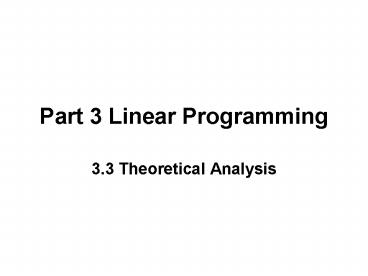Part 3 Linear Programming - PowerPoint PPT Presentation
Title:
Part 3 Linear Programming
Description:
Part 3 Linear Programming 3.3 Theoretical Analysis Matrix Form of the Linear Programming Problem LP Solution in Matrix Form Tableau in Matrix Form Criteria for ... – PowerPoint PPT presentation
Number of Views:58
Avg rating:3.0/5.0
Title: Part 3 Linear Programming
1
Part 3 Linear Programming
- 3.3 Theoretical Analysis
2
Matrix Form of the Linear Programming Problem
3
LP Solution in Matrix Form
4
Tableau in Matrix Form
5
Criteria for Determining A Minimum Feasible
Solution
6
(No Transcript)
7
(No Transcript)
8
Theorem (Improvement of Basic Feasible Solution)
- Given a non-degenerate basic feasible solution
with corresponding objective function f0, suppose
for some j there holds cj-fjlt0. Then there is a
feasible solution with objective value fltf0. - If the column aj can be substituted for some
vector in the original basis to yield a new basic
feasible solution, this new solution will have
fltf0. - If aj cannot be substituted to yield a basic
feasible solution, then the solution set K is
unbounded and the objective function can be made
arbitrarily small (negative) toward minus
infinity.
9
Optimality Condition
- If for some basic feasible solution cj-fj or rj
is larger than or equal to zero for all j, then
the solution is optimal.
10
Symmetric Form of Duality (1)
11
Symmetric Form of Duality (2)
- MAX in primal MIN in dual.
- lt in constraints of primal gt in constraints of
dual. - Number of constraints in primal Number of
variable in dual - Number of variables in primal Number of
constraints in dual - Coefficients of x in objective function RHS of
constraints in dual - RHS of the constraints in primal Coefficients
of y in dual - f(xopt)g(yopt)
12
Symmetric Form of Duality (3)
13
Example
Batch Reactor B
Batch Reactor C
Batch Reactor A
Products P1, P2, P3, P4
Raw materials R1, R2, R3, R4
P1 P2 P3 P4 capacity time
A 1.5 1.0 2.4 1.0 2000
B 1.0 5.0 1.0 3.5 8000
C 1.5 3.0 3.5 1.0 5000
profit /batch 5.24 7.30 8.34 4.18
time/batch
14
Example Primal Problem
15
Example Dual Problem
16
Property 1
- For any feasible solution to the primal problem
and any feasible solution to the dual problem,
the value of the primal objective function being
maximized is always equal to or less than the
value of the dual objective function being
minimized.
17
Proof
18
Property 2
19
Proof
20
Duality Theorem
- If either the primal or dual problem has a finite
optimal solution, so does the other, and the
corresponding values of objective functions are
equal. If either problem has an unbounded
objective, the other problem has no feasible
solution.
21
Additional Insights
22
Symmetric Form of Duality (3)
23
LP Solution in Matrix Form
24
Relations associated with the Optimal Feasible
Solution of the Primal problem
25
Example
PRIMAL
DUAL
26
(No Transcript)
27
Tableau in Matrix Form
28
(No Transcript)
29
Example The Primal Diet Problem
- How can we determine the most economical diet
that satisfies the basic minimum nutritional
requirements for good health? We assume that
there are available at the market n different
foods that the ith food sells at a price ci per
unit. In addition, there are m basic nutritional
ingredients and, to achieve a balanced diet, each
individual must receive at least bj unit of the
jth nutrient per day. Finally, we assume that
each unit of food i contains aji units of the jth
nutrient.
30
Primal Formulation
31
The Dual Diet Problem
- Imagine a pharmaceutical company that produces in
pill form each of the nutrients considered
important by the dietician. The pharmaceutical
company tries to convince the dietician to buy
pills, and thereby supplies the nutrients
directly rather than through purchase of various
food. The problem faced by the drug company is
that of determining positive unit prices y1, y2,
, ym for the nutrients so as to maximize the
revenue while at the same time being competitive
with real food. To be competitive with the real
food, the cost a unit of food made synthetically
from pure nutrients bought from the druggist must
be no greater than ci, the market price of the
food, i.e. y1 a1i y2 a2i ym ami lt ci.
32
Dual Formulation
33
Shadow Prices
- How does the minimum cost change if we change the
right hand side b? - If the changes are small, then the corner which
was optimal remains optimal. The choice of basic
variables does not change. At the end of simplex
method, the corresponding m columns of A make up
the basis matrix B.
34
(No Transcript)































